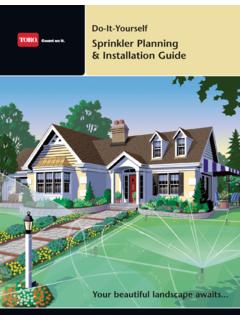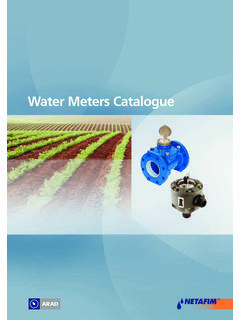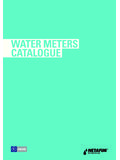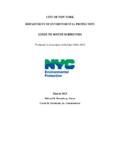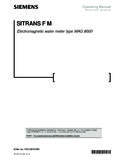Transcription of Vulnerabilities of Wireless Water Meter Networks
1 1 Vulnerabilities of Wireless Water Meter Networks Black Hat USA Las Vegas August 3, 2011 by John McNabb Abstract. Why research Wireless Water meters ? Because they are a potential security hole in a critical infrastructure, which can lead to a potential leakage of private information, and create the potential to steal Water by lowering Water bills? It's a technology that's all around us but seems to too mundane to think about. Because a hacker can't resist exploring technology to see how it works and how to break because they are there? In this talk the speaker, who managed a small Water system for 13 years, will first present an overview of drinking Water security, review reported Water system security incidents and the state of drinking Water security over the past year, and will then take a deep dive into the hardware, software, topology, and Vulnerabilities of Wireless Water Meter Networks and how to sniff Wireless Water Meter signals.
2 ORGANIZATION OF THIS PAPER: Section Page (1) Introduction 1 (2) Water meters 2 (3) Wireless Water Meter sensor Networks 4 (4) The year in drinking Water security 9 (5) Security issues of Wireless Water Meter sensor Networks 23 (6) Hacks of other smart meters and Wireless devices 30 (7) Methods that I am working on to sniff Water meters 33 (8) Conclusion 34 (9) References 35 I. INTRODUCTION US drinking Water utilities collect $40 billion annually, and depend on the readings from Water meters for this income. Wireless Water meters , while providing quantifiable benefits to a local drinking Water utility and their customers, may also result in security Vulnerabilities . Water utilities have historically been a target for attacks by nation states, terrorists, and others, and need to do more to protect their critical assets from potential attack.
3 This paper discusses the specific facts and issues concerning Wireless Water meters , in their various forms as Automatic Meter Reading, Advanced Metering Infrastructure, and as part of an overall Smart Grid infrastructure which includes electric and gas utilities. Furthermore, the larger context of drinking Water security is also addressed to put this potential risk in context. Finally, the various security and privacy issues raised by Wireless Water meters are discussed. 2 II. Water meters A Water Meter is a device which collects and registers information on the volume of Water used over a period of time at a particular location. The resultant information, which is the volume of Water used in gallons or cubic feet since the installation of the Meter , is used to calculate the amount charged by the local drinking Water utility to the customer for Water usage at that location for that billing period.
4 How meters work Water meters1 are typically composed of metal, usually brass or copper, but sometimes plastic, and typically range in size from 5/8 to 2 diameter for residential and commercial customers. The most common type of Meter used is a positive displacement Meter , which uses a vane, piston, diaphragm, or disk to separate measured volumes of Water and count these measured volumes to indicate the accumulated volume on the Meter register. Overall, there are four major types of meters : positive displacement, velocity, compound, and electromagnetic meters . There are two types of positive displacement meters : nutating disc and piston. There are six types of velocity meters : turbine, multi-jet, propeller, ultrasonic, venture, and orificemeters. Compound meters include both positive displacement Meter , for low-flow conditions, and velocity Meter , for high-flow conditions.
5 The Meter register is a mechanical or digital display which indicates the volume of Water which has flowed through the Meter since its installation. One of the oldest types is the dial read Meter , which shows a series of dials showing the volume used in ones, tens, hundreds, thousands, etc. of gallons or cubic feet. One of the most common shows the Water volume on an increasing counter similar to an automobile odometer. Many registers have a red leak detector hand or triangle which, if moving when all Water usage is shut off, indicates that there is a leak. Importance of metering Water meters are an important component2 of a local drinking Water utility for a number of reasons. They allow the utility to: (a) charge customers for the volume of Water used, (b) monitor the total amount of Water produced and sent to the distribution system, and (c) detect and fix leaks in the distribution system.
6 They allow the customer to: (a) monitor the volume of Water they are using, (b) have some control over their Water bill, (c) detect and fix leaks at their location, and (d) take measures to conserve Water . Accurate metering3 is also required for effective accounting and rate making, to identify and study peak and non-peak Water use, verification of Water and cost savings, the implementation of Water efficiency and conservation measures, to allow the utility to make 1 Control and Mitigation of Drinking Water Losses in Distribution Systems, EPA (Environmental Protection Agency), USA, November 2010, Chapter 2, Metering, pp. 3-1 through 3-13 2 Satterfield, Zane and Vipin Bhardwaj, Tech Water meters , National Environmental Services Center at West Virginia University, Tech Briefs, Summer, 2004 3 Water Meter calibration, repair, and replacement program, Georgia Environmental Protection Division, August 2007 3 informed decisions on operations, maintenance, capital investment, and customer service, and to facilitate and improve management of the Water utility Accuracy of metering & billing Water meters are not perfect instruments, and do not always provide accurate measurements.
7 Over time, as the Meter ages, wear and tear on the components and the accumulation of sediment, lime scale, and impurities reduces the accuracy of the Meter . For example, a Water audit conducted by the city of Tampa, Florida, found that inaccurate meters cost the city $2,473,535 in FY20054. Dubuque, Iowa projected5 in a 2009 Water Meter testing program that inaccurate meters would cost the city $676,000 in lost revenue, about of the projected Water and wastewater revenue for that fiscal year. Proper management of the metering and billing system is also important to provide the needed level of revenues to the utility and to sustain public confidence in the system. The June, 2011 audit6 of the Brockton, Mass. Water & Sewer Department found that most of the City s meters were 15 years or older, that FY2006 though FY2010 approximately 25% of the Water bills were not based on reading the Meter but were estimated readings, and that the billing staff did not have sufficient training in using the system.
8 The audit was called for by the City Council following the issuance of numerous retroactive bills to residents, resulting in one case of a Water bill of $97,000 for one homeowner. Meter tampering Tampering of Water meters is a serious issue which costs money for Water utilities. For example, Water Meter tampering has been reported to be on the rise in Temple, Texas, Georgetown, South Carolina, Taylor Texas (which reported losing million gallons in FY 2010), Lavergne, Tennessee, Pleasant Grove, Utah, and Mammoth Springs, Arkansas. The motive is to steal Water and pay less in Water bills. These jurisdictions and other have been passing laws to punish Water Meter tampering. Information from meters Historically, prior to the introduction of Wireless and other automatic reading of Water meters , the amount of information and the purposes for which it could be used were rather limited.
9 meters are usually located in the basement of a home or in a Meter pit at the property boundary, and have historically been manually read only once every 3 months or, in some cases, monthly. 4 Pickard, Brad D., Jeff Vilagos, Glenn K. Nestel, Rudy Fernandez, Stephen Kuhr, and Daniel Lanning, Reducing non-revenue Water : a myriad of challenges, Florida Water Resources Journal, May, 2008. 5 Dubuque Water Meter Review and Testing - Final Water Meter Review and Testing Phase Two, HDR Engineering, Inc. March 2009 6 Review of policies, practices, and procedures of the City of Brockton s Water and Sewer Department, The Abrahams Group, Woodward & Curran, June, 2011. 4 This evolution of automatic reading methods for Water meters has resulted in an expansion of the information that can be gleaned from Water meters and the purposes which this information can be used.
10 III. Wireless Water Meter SENSOR Networks The methodology and technology for reading Water meters has evolved greatly since the 1980 s, producing major improvements in the technology and concomitant increases in the quantity and quality of the information collected. Water meters have thus evolved from stand alone devices to networked devices working in a sometimes complex sensor network providing information services that the inventors of Water meters decades ago never would have imagined was possible. A. Evolution of Meter reading methods (1) Eyeball This is the legacy method which requires a Meter reader to physically enter the premises and read the Meter , usually in the basement. The Meter reader eyeballs the register and writes down the numbers on a sheet in a location corresponding to the customers account number.




